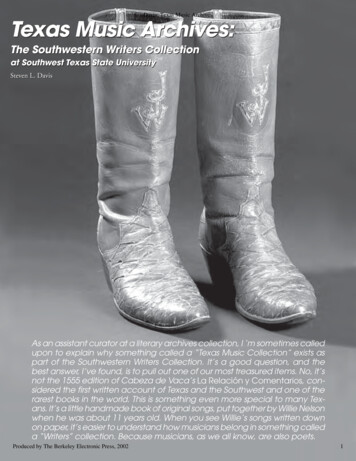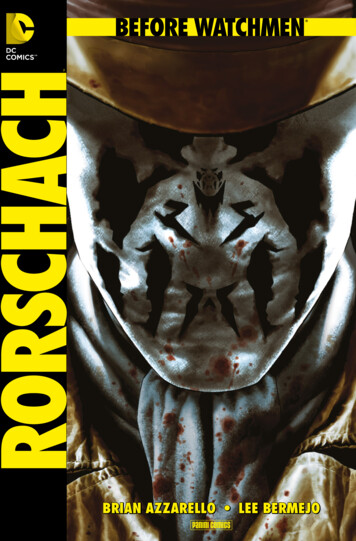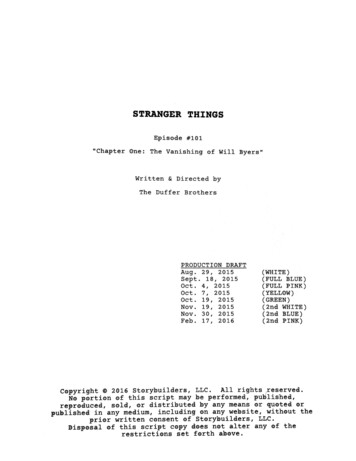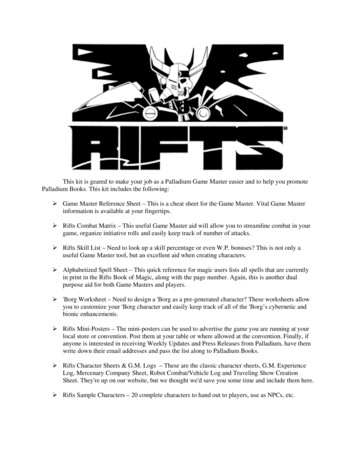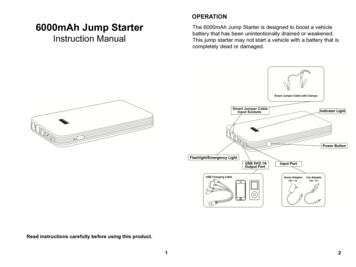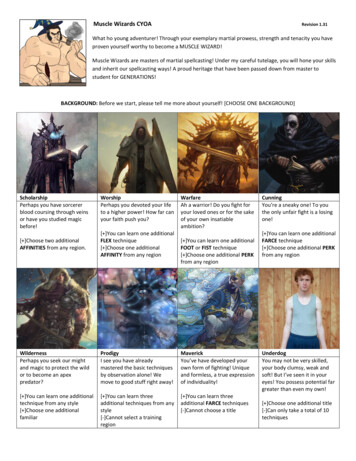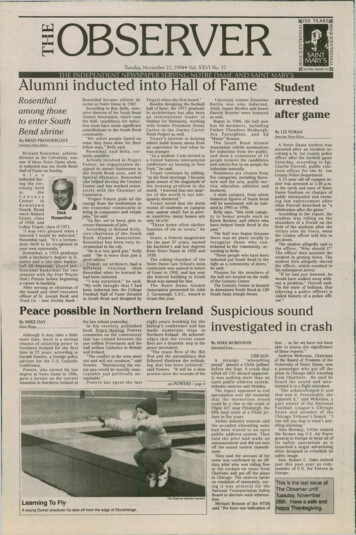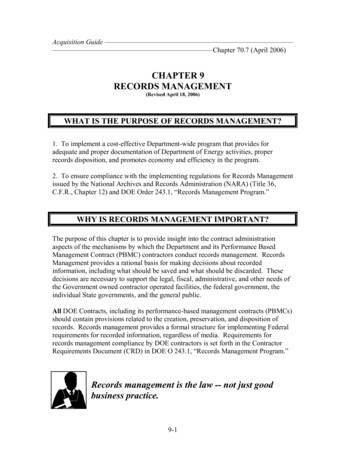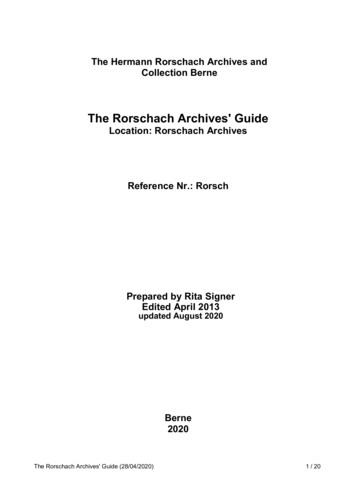
Transcription
The Hermann Rorschach Archives andCollection BerneThe Rorschach Archives' GuideLocation: Rorschach ArchivesReference Nr.: RorschPrepared by Rita SignerEdited April 2013updated August 2020Berne2020The Rorschach Archives' Guide (28/04/2020)1 / 20
Table of contentIntroduction . 3General Information . 4Use . Fehler! Textmarke nicht definiert.Address . Fehler! Textmarke nicht definiert.Inventory of the Archives . 61 Fonds Adolf Friedemann . 62 Fonds Arnold Weber . 73 Fonds Elisabeth Rorschach . 74 Fonds Emil Lüthy . 85 Fonds Emil Oberholzer . 96 Fonds G.A. Roemer . 107 Fonds Hans Behn-Eschenburg . 118 Fonds Gertrud Behn-Eschenburg . 129 Fonds Hermann Rorschach . 1210 Fonds Kenower W. Bash . 1311 Fonds Marguerite Loosli-Usteri. 1412 Fonds Max Müller . 1613 Fonds Olga Rorschach . 1714 Fonds Wadim Rorschach . 1815 Fonds Walter Morgenthaler . 1816 Fonds Wolfgang Schwarz . 20The Rorschach Archives' Guide (28/04/2020)2 / 20
IntroductionThe Hermann Rorschach Archives and Collection is dedicated to one single man who,through his work, became world famous: the Swiss psychiatrist and creator of the testnamed after him: Hermann Rorschach (1884-1922).Initiated in 1957 by the Bernese psychiatrist Walter Morgenthaler (1882-1965) theinstitution, administered by the Institute of the History of Medicine of the University of Berne(IMG), fulfils an important function in the international Rorschach research. It is sponsoredby, besides the IMG, the International Society of the Rorschach and Verlag Hans HuberHogrefe AG.The Hermann Rorschach Archives and Collection houses records and other items fromHermann Rorschach's estate as well as from the estates of his wife and children, of formerprofessional colleagues and of past presidents of the International Society of the Rorschach.Its purpose is to preserve this inheritance for posterity, in as far as possible to extend it andto provide electronic finding aids.The fonds are being described progressively according to the standard ISAD(G) inthe Online Union Catalog Handschriften, Archive und Nachlässe hische-gliederung/A library with numerous publications from all over the world documents the receptionand further development of Rorschach's work.To find the books of the Rorschach Library go to :https://www.swissbib.ch/Search/Advanced, select as field “call nr”, type “IMGRorsch”The Hermann Rorschach Archives and hach archives and collection/index eng.htmlThe Archives on Online Union Catalog HANhttps://aleph.unibas.ch/F/?func option-update-lng&file name findb&p con lng GER&local base rorschachThe Rorschach Archives' Guide (28/04/2020)3 / 20
General InformationAddressArchiv und Sammlung Hermann Rorschach / The Hermann Rorschach Archives andCollectionInstitut für Medizingeschichte, Universität BernBühlstrasse 26CH-3012 BernSwitzerlandArrival by public transports: from the main station Bus No. 20 direction Länggasse to busstop Mittelstrasse. Arrival by car: motorway exit Bern-Forsthaus.UseThe use of the Rorschach Archives and Library for scientific purposes is open to all, butnotice is required in advance. Generally, the access to the archives is not restricted. Thereproduction of documents is permitted only with the approval of the International RorschachSociety.Since the relocation of the archives and the closure of the museum in 2012, guided tours forgroups and individuals aren’t possible any more.Lending of books and articles/Contact Rorschach LibraryWith a few exceptions all books may be borrowed. Articles form periodicals or journals areavailable only as photocopies.Borrowers from outside Switzerland: for books please use interlibrary loan, for articles fromperiodicals contact us per e-mail.Contact: ek/index ger.htmlopening times of the bibliothek/index ger.htmlContact Rorschach h archives and collection/index eng.html#pane617186Since the position of the archivist is a part time post, please contact us per e-mail and beaware that our reply may take some time. Thank you for your comprehension.Reference Code Ref.Code: Rorsch ISIL:CH-000956-2The Rorschach Archives' Guide (28/04/2020)4 / 20
The Hermann Rorschach Archives and ach archives and collection/index eng.htmlOnline Catalog Rorschach Archives on Union Catalog HANSearching the archives:https://aleph.unibas.ch/F/?func option-update-lng&file name findb&p con lng GER&local base rorschachLooking at the archival ierarchische-gliederung/Rorschach Libraryhttps://www.swissbib.ch/Search/Advanced, select as field “call nr”, type “IMGRorsch”The Rorschach Archives' Guide (28/04/2020)5 / 20
Inventory of the Archives1Fonds Adolf FriedemannRef. Nr.TitleExtentRorsch AF.Fonds Adolf Friedemann.2 cm.ContentThe small fonds contains some results obtained through a test developedby a certain Mr. Theo Lüdi (L-Test) and through the Z-Test.Biogr.Adolf Friedemann was born on 26th May 1902. He studied psychologyand medicine in Berlin and Jena, finished his medical studies in Freiburgim Breisgau in 1915 and remained there as assistant and resident at theNeurological and Psychiatric Clinic of the University of Freiburg until1929. His interest in medical pedagogy manifested itself early, leadinghim to become Deputy to the Chief of the Medico- Pedagogic CounsellingCenter in 1926. He moved nearby Switzerland in 1930 and was scientificassistant to Prof. R. Staehelin at the University Psychiatric Clinic of Basel,but a position of Senior Resident in the Neurological Division of theHospital Berlin-Buch combined with a research appointment to the KaiserWilhelm Institute for Brain Research attracted him to Germany for twoyears until in 1933 he returned to Switzerland. Here began his lifelongfriendship with the psychoanalyst and pioneer in the mental healthmovement, Heinrich Meng. He worked at the Cantonal PsychiatricHospital of Bellelay from 1934 to 1949 and acquired there Swisscitizenship.In 1949 he was called to take charge of the Institute for Mental Hygienein the bilingual city of Biel. Here he could employ to the full his diagnosticskills in the Rorschach, the Szondi and the Pfister-Heiss Color PyramidTests besides others, working principally with young people andadolescents as fitted his inclination. When the first InternationalRorschach Congress was held in Zürich in 1949 Friedemann was one ofthe organizers, and at the second in Bern in 1952 he was electedSecretary of the new International Rorschach Society. His old university,Freiburg, gave him a Lectorate for Mental Health and PracticalPsychology in 1954 and conferred the title of Professor on him soonthereafter. After he retired from the Institute for Mental Hygiene in 1969he devoted himself intensively to the development of group therapy on apsychoanalytic basis. From 1970 on he took up lecturing on theRorschach Test and other subjects at the Swiss University of Freiburgbesides medical supervision at the Out- Patient Service of its Institute forMental Health.Devoted to the Rorschach Test throughout his professional life,Friedemann became Chairman of the Rorschach Commission of theSwiss Psychological Association, of which he was a founding member, in1960 and remained in that position until 1975. From 1960 to 1981 he waspresident of the International Rorschach Society. Friedemann’spublications on the Rorschach include studies on the diagnosis ofschizophrenia, on blind diagnosis by means of the test on its comparisonwith the parallel Behn Rorschach series and the Zulliger Test as well asa number of remarks and notes. (Text from K. W. BashThe Rorschach Archives' Guide (28/04/2020)6 / 20
in Journal of personality assessment vol. 46, 1982, p. 111-112).AcquisitionFinding aidsAction2Inventory not yet existing.Description: Recorded by Rita Signer / July 2007.Fonds Arnold WeberRef. Nr.TitleExtentContentArrangementRorsch AW.Fonds Arnold Weber.4 boxes (various sizes).The fonds contains among other things Rorschach protocols ofprofessional musicians and other talented persons recorded by A. Weberwith elaborate summaries by H. Rorschach.Organised in 2 series: 1) Correspondence 2) Test protocols and notes.Biogr.Arnold Weber (1894-1976) was musician at first. In 1922 he beganpsychoanalysis with Hermann Rorschach, after Rorschach's death hecontinued with Emil Oberholzer. He then studied medicine, worked in thepsychiatric clinic Burghölzli in Zürich, later in the psychiatric clinic Waldaunear Bern. In 1938 he qualified as university lecturer, in 1954 he wasappointed extraordinary professor for child psychiatry in Bern. As studenthe joined the Swiss psychoanalytic society. He worked as psychoanalystin a private practice and made full use of Rorschach's test. In 1921/22 A.Weber sent H. Rorschach records of professional musicians and otherpersons for interpretation.AcquisitionDonated by Dr. med. Kaspar Weber (son of Arnold Weber) in September2000.Action3Legacy of Prof. Adolf Friedemann. Received in march 1982.Description: Recorded by Rita Signer / January 2012.Fonds Elisabeth RorschachRef. Nr.TitleExtentArrangementBiogr.Rorsch ER.Fonds Elisabeth Rorschach.2 boxes (13 cm).1) Biographical material 2) Correspondence 3) Various documents.Elisabeth Rorschach, the daughter of Hermann and Olga Rorschach,was born on 18th June 1917 in Herisau (Canton Appenzell A.Rh.), whereher father had been employed since 1915 as a psychiatrist in theCantonal Psychiatric Clinic. Her parents called her Lisa, and she usedthis name herself throughout her life. She grew up bilingually (Germanand Russian) but, as she relates in her curriculum vitae, after the deathof her father in 1922 her ability to speak Russian had more and morediminished. When her father died Lisa was not even five years of age,and her younger brother, Wadim, just three. Her mother, herself amedical doctor, was compelled to provide for the family, and initially shecontinued the clinical work of her deceased husband. After two yearsThe Rorschach Archives' Guide (28/04/2020)7 / 20
she moved with her two children to Teufen (Canton Appenzell A.Rh.).After her school years in Teufen and later at the Cantonal SchoolSt.Gallen Lisa Rorschach studied the English and Romance languagesand literature at the University of Zurich and there in 1947 completed herstudies. Afterwards she lived for some time in Scotland before settling inZurich, where, until her retirement, she taught at the Business College ofthe Commercial Association. In 1953 she took her aging mother into herflat in the outskirts of Zurich. She died unexpectedly on the 15th August2006 during a holiday in her beloved Appenzell.AcquisitionAction4Bequeathed to the Rorschach-Archives by Elisabeth Rorschach. 2006.Description: August 2011.Fonds Emil LüthyRef. Nr.TitleExtentRorsch EL.Fonds Emil Lüthy.2 cm.ContentThe small fonds includes among other things correspondence withRorschach and drawings relating to Rorschach’s test.Arrangement1) Letters 2) Drawings relating to Rorschach's test 3) Papers relating tothe Swiss Psycho-Analytical Society 4) Photos.Biogr.Emil Lüthy was born on 13th March 1890 in Basle where he went toschool. He was a cousin of Emil Oberholzer, with whom he had a fairlyclose relationship. According to his own statements he was afflicted fromhis early youth with health problems. He seemingly was interested bothin medicine and art, but precise information on his career is scarce. Invarious obituaries he is stated to have gone, after school leavingexaminations qualifying for university in 1911, to Munich where heallegedly studied for three years. It is, however, unclear what sort ofstudies they were. At any rate in the student directory of the University ofMunich of that time one cannot find his name. After returning to Basleshortly before the outbreak of World War I he attended until 1915 paintingclasses conducted by Hermann Meyer (1878-1961). For furthereducation in painting he is said to have been in Italy, Vienna and Paris.In all likelihood influenced by Emil Oberholzer he became intrigued bypsychoanalysis. From a letter from Oscar Pfister to Emil Oberholzer from29th March 1920 we learn that Lüthy was in psychoanalysis with OscarPfister in 1919. He numbered among the first members of the SwissPsycho-Analytical Society established in the same year, holding from1920 onwards the position of treasurer. On the register of members he islisted as painter showing that he considered himself as such. Havingbeen in psychoanalysis with Freud in 1923 he later was approached byKurt Eissler, director of the Sigmund Freud Archives, for a recollection ofhis experience with Freud. As can be proven he studied medicine from1924 to 1927 at the university in Zurich, where he lived with Emil and MiraOberholzer. Thereafter he seems to have turned exclusively to painting.The emigration of Emil and Mira Oberholzer to USA in 1938 meant animportant loss for Lüthy. The same is true with regard to his friendFrederic S. Weil, who also emigrated to USA, where he became a wellknown psychoanalyst.The Rorschach Archives' Guide (28/04/2020)8 / 20
In 1920 Rorschach asked Emil Lüthy for advice in connection with thedifferentiation of talents according to introversive and extratensivefeatures. Seeking a better understanding of the role of certain colours inthe context of his introversion-extratension scheme he turned again tohim in 1922. Moreover Lüthy provided Rorschach with test records ofpersons of his acquaintance for evaluation.AcquisitionAction5Donated by Erika Würz, Allschwil/BL on 13th October 2008.Description: Recorded by Rita Signer / April 2009.Fonds Emil OberholzerRef. Nr.TitleExtentContentArrangementBiogr.Rorsch EO.Fonds Emil Oberholzer.3 cm.The fonds consists of the correspondence between E. Oberholzer andH. Rorschach in the years 1916 to 1922 and Oberholzer'scorrespondence with various persons, mainly with Walter Morgenthaler.Organised in 2 files.Emil Oberholzer was born of Swiss parents on 24th December 1983 inZweibrücken (Germany) where his father managed a factory. The familywent back to Switzerland when Emil was still young. He grew up in Zurichand there in 1902 began his medical studies which, after intermediatesemesters in Geneva and Basle, he completed in Zurich in 1908.Thereafter, for over two years, he was assistant to Eugen Bleuler at theBurghölzli in Zurich where he met his future wife Mira Gincburg (18871949), also an assistant. Later on both worked at the psychiatric hospitalBreitenau (in Schaffhausen). In October 1911 Oberholzer joined theGroup of Zurich (“Zürcher Ortsgruppe“) affiliated to the InternationalPsychoanalytical Society, and in 1912 went to Vienna to be analysed bySigmund Freud.From 1916 on the couple worked at the nerve sanatorium of Dr. Brunnerin Küsnacht (Canton Zurich) and in 1919 went into private practicetogether in Zurich. In the same year the Swiss Psycho- Analytical Societywas founded and Oberholzer was elected as its first president. In 1928he formed the Swiss Medical Society for Psychoanalysis, this actionbeing the outcome of dissensions over lay or wild analysis. Oberholzertrained many analysts, and so did his wife, who had been with Freud inthe early 1920‘s. In 1926 their son Emil Hermann was born. Worriedabout the growing menace from Nazi Germany – Mira was Jewess – in1938 the couple emigrated to New York, where they worked aspsychoanalysts in private practice. In 1941 Oberholzer became anhonorary member of the New York Psychoanalytic Society.According to the psychoanalyst Frederic S. Weil Oberholzer “was not asimple man. He was intense and incisive, proud and passionate andprone to stand back independently if he could not agree. He withdrewmore and more, even from close friends, and more so after his wife’sdeath in 1949“ (From a manuscript “In memoriam Dr. EmilOberholzer“1958, kept by the Institut für Medizingeschichte in Berne)Oberholzer died on 4th May 1958 at the age of seventy-five.The Rorschach Archives' Guide (28/04/2020)9 / 20
Emil Oberholzer made a number of contributions to psychiatry in variousfields (heredity, sterilisation, epilepsy) and to clinical psychoanalysis. Hismain interest, however, was the Rorschach Test. Oberholzer andRorschach met each other probably as early as in their student days inZurich, but they became friends only in 1919. Oberholzer took an activepart in Rorschach’s experiment. Using Rorschach's cards he conductedtests on his own clients and sent the recorded answers to Rorschach forevaluation. In 1923 he published posthumously his friend’s lecture “ZurAuswertung des Formdeutversuchs für die Psychoanalyse” (Theapplication of the interpretation of form to psychoanalysis, 1924) whichRorschach had presented to the Swiss Psycho-Analytical Society a fewweeks before he passed away. Until the end of his life Oberholzer workedon Rorschach’s test incessantly. He did extensive consultation work andwas a recognised authority on the test.AcquisitionAction6Donated by Emil Oberholzer, Jr., Ph.D., New York (son of Dr. med. EmilOberholzer), transmitted by Walter Morgenthaler in August 1958.Description: Recorded by Rita Signer / October 2008.Fonds G.A. RoemerRef. Nr.TitleExtentRorsch GR.Fonds G.A. Roemer.ca. 350 cm.ContentThe fonds is made up of, among other things, the extendedcorrespondence between G. A. Roemer and H. Rorschach from 1919until 1922. Roemer, having experimented for decades seeking newtechniques for the preparation of test pictures, left an immense numberof sheets, which are interesting for their aesthetic and artistic value.Complemented by some of the other papers and non-published literatureof the time, the letters received and sent by Roemer are an importantsource of knowledge on the history of psychotherapy during the Nazi rulein Germany.ArrangementOrganised in 6 series: 1) Biographical material 2) Correspondence 3)Scientific material 4) Institutes and societies 5) Test pictures 6)Photographs.Biogr.Georg August Herman
After her school years in Teufen and later at the Cantonal School St.Gallen Lisa Rorschach studied the English and Romance languages and literature at the University of Zurich and there in 1947 completed her studies. Afterwar
